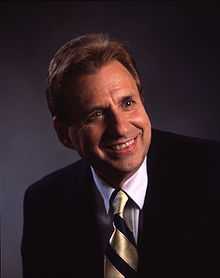John D. Kasarda

John D. Kasarda is an American academic focused on global management strategy, aviation and economic development. He is currently the Kenan Distinguished Professor of Strategy and Entrepreneurship at the Kenan-Flagler Business School at the University of North Carolina at Chapel Hill where he directs the Center for Air Commerce.
Kasarda is the developer[1] [2] of the “aerotropolis” concept,[3][4][5][6][7][8][9][10][11] which defines the roles of aviation and airports in shaping 21st-century business location, urban competitiveness, and economic growth. In 2011 Time magazine named the airport-centered concept as one of the "10 Ideas that Will Change the World."[12] He is co-author with Greg Lindsay of Aerotropolis: The Way We'll Live Next, released in March 2011 by Farrar, Straus and Giroux.
Education
Kasarda earned a Bachelor of Science degree in Applied Economics from Cornell University in 1967, a Masters of Business Administration degree in Organizational Theory from Cornell in 1968, and a Ph.D. in Sociology from the University of North Carolina at Chapel Hill in 1971.
Selected Professional Appointments (as of May 2011)

- Director, Prologis Institute Alliance RETI, 2005–present
- Director, Old Dominion Freight Line Inc., 2008–present
- Board of Advisors, International Society of Logistics, 2004–present
- Board of Directors, Institute for Defense and Business, 2002–present
- Board of Trustees, Urban Land Institute, 2000-2010
- Member, Advisory Committee, National Aerospace Laboratories (NAL), 2008–present
- Member, International Economic Development Council, 1999–present
- Fellow, American Association for the Advancement of Science, 1997–present
- Advisory Board, United States Government Accountability Office on the A380 super jumbo airplane entering U.S. service, 2005-2009
- Member, Academy of International Business, 1995–present
- Member, National Association of Business Economists, 1992–present
- Member of American Sociological Association, 1990–present
- Board of Governors, World Food Logistics Organization, 1999-2002
- Board of Directors, Foundation for Transportation, Trade, and Commerce, 1998-2002
- Member, Advisory Board, The Odum Institute for Research in Social Science, 2000-2004
- Board of Directors, Consortium of Social Science Associations, 1996-2001
- Member, Advisory Council, North Carolina Alliance for Competitive Technologies (NC ACTs), 1994–present
- Nominating Committee, Eisenhower Exchange Fellowships, 1999-2008
- Member, The Counselors of Real Estate, 1999-2008
References
- ↑ "Logistics & the Rise of the Aerotropolis". Real Estate Issues: 43–48. Winter 2000/2001.
- ↑ Kasarda, John D. (2000). "Aerotropolis: Airport-Driven Urban Development". ULI on the Future: Cities in the 21st Century. Washington, D.C.: Urban Land Institute
- ↑ "Aerotropolis". World Wide Words.
- ↑ "Aerotropolis". World Spy.
- ↑ Mihm, Stephen (Dec 10, 2006). "The 6th Annual Year in Ideas; The Aerotropolis". New York Times Magazine.
- ↑ Lindsay, Greg (July/August 2006). "Rise of the Aerotropolis". Fast Company.
- ↑ England, Vaudine (March 16, 2006). "Free Flow: All the world’s roads may lead to aerotropoli". International Herald Tribune.
- ↑ "Kansas City International Airport Gaining Momentum as Dominant Aviation Center in Nation’s Heartland". Kansas City Infozine. Aug 6, 2005.
- ↑ "Aerotropolis’ to Make a Major Impact on Commercial Development". EC&M. Dec 1, 2005.
- ↑ "Business on the Fly". Economist. Nov 24, 2005.
- ↑ Nasser, Haya El (Sep 25, 2003). "New "cities" springing up around many U.S. airports". USA Today.
- ↑ Iyer, Pico (Mar. 17, 2011). "Ten Ideas That Will Change the World." Time.
External links
- Kenan-Flagler Business School Faculty Biography for John D. Kasarda
- Aerotropolis.com, Dr. John D. Kasarda's Web site about the development of aerotropolises
- Kenan Institute of Private Enterprise at the University of North Carolina, Chapel Hill
- The Center for Air Commerce website